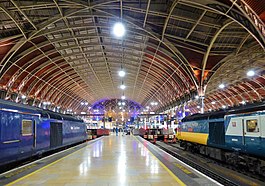
Back بادنغتون (محطة مترو أنفاق لندن) Arabic محطة بادينجتون ARZ লন্ডন প্যাডিংটন স্টেশন Bengali/Bangla Estació de London Paddington Catalan Gorsaf reilffordd Paddington Llundain Welsh Paddington Station Danish Bahnhof Paddington German London Paddington station English Paddington (stacidomo) Esperanto Estación de Paddington Spanish
| Paddington | |
|---|---|
| London Paddington | |
 The Victorian train shed at Paddington at Night | |
| Location | Paddington |
| Local authority | City of Westminster |
| Managed by | Network Rail |
| Owner | Network Rail |
| Station code | PAD |
| DfT category | A |
| Number of platforms | 13 |
| Accessible | Yes[1] |
| Fare zone | 1 |
| OSI | Paddington Bakerloo, Circle and District lines station Paddington Circle and Hammersmith & City lines station Marylebone Lancaster Gate |
| Cycle parking | Yes |
| Toilet facilities | Yes |
| National Rail annual entry and exit | |
| 2013–14 | |
| 2014–15 | |
| 2015–16 | |
| 2016–17 | |
| Railway companies | |
| Original company | Great Western Railway |
| Key dates | |
| 4 June 1838 | Temporary station opened |
| 29 May 1854 | Permanent station opened |
| Other information | |
| External links | |
| WGS84 | 51°31′02″N 0°10′39″W / 51.5173°N 0.1774°W |

Paddington railway station,[4] also known as London Paddington,[5] is the main National Rail and London Underground station in northwest central London. It also has access to the Elizabeth Line.
The site is old. It has been as the London end of the Great Western Railway and its successors since 1838. Much of the current mainline station dates from 1854, and was made by Isambard Kingdom Brunel. The site was first served by Underground trains in 1863, and was the first western end-point of the Metropolitan Railway, the world's first underground railway.
The station now has an extra job as the London end point for the Heathrow Express airport service. Paddington is in Travelcard Zone 1.
- ↑ "London and South East" (PDF). National Rail. September 2006. Archived from the original (PDF) on 6 March 2009.
- ↑ "Out of Station Interchanges" (XLSX). Transport for London. 16 June 2020. Retrieved 5 November 2020.
- ↑ 3.0 3.1 3.2 3.3 "Station usage estimates". Rail statistics. Office of Rail Regulation. Please note: Some methodology may vary year on year.
- ↑ "Stations Run by Network Rail". Network Rail. Retrieved 9 July 2012.
- ↑ "Station Codes". National Rail. Archived from the original on 25 November 2012. Retrieved 9 July 2012.
